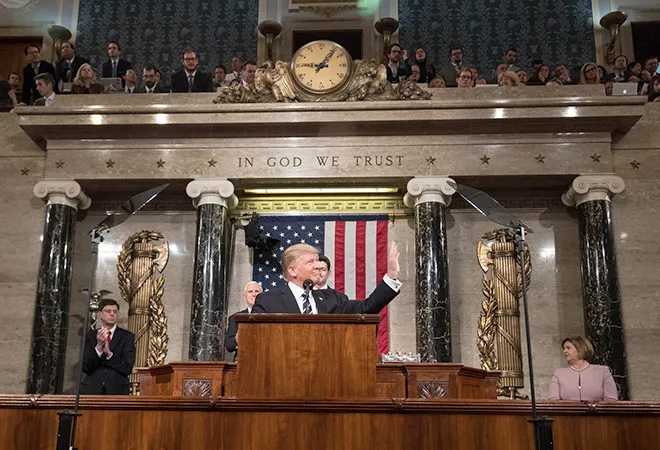-
CENTRES
Progammes & Centres
Location
There is still time to bring a package on the table.

There is something uneasy about US President Donald Trump’s actions on the trade front and his trying to fulfil his pledge of ‘making America great again.’ His policies are clearly protectionist in stance and involve arm twisting of big emerging countries into buying more American goods on the one hand and restraining their own exports to the US, on the other. The recent action against India is a case in point because the US announced on 4 March that it will be withdrawing the over 40 years old GSP (Generalised System of Preferences) tariff treatment that the US granted in the past to Indian imports. The GSP was introduced by the US for India in 1976. And it enabled 1,900 Indian exports to enter US duty free.
The US had already announced in November 2018 that it would be withdrawing its trade preference programme on $75 million of Indian exports using product specific competitiveness limits defined in the GSP regulation. It means that in case imports from a developing country like India reaches $185 million, the country loses the GSP benefit. Currently, only a fraction of India’s exports to the US enjoys GSP preference, and according to the NDA government, the amount of loss on customs duties would be only $190 million in case it is withdrawn. The preferential treatment of goods from developing countries was introduced in the 1960s and 70s under GATT (the precursor of WTO) as a positive gesture by developed countries to help the developing countries with trade and growth. It allowed duty free market access to poor countries’ products to enter developed countries’ markets.
India is not a middle-income country yet — and even though Trump has referred to India as the third biggest economy in the world, and questioned why it deserves any special tariff treatment in trade — the truth is that India is much poorer per capita income wise.
The EU had decided in 2014 that upper middle-income countries would not be eligible for special access under GSP as they were industrialising rapidly and were highly competitive vis-à-vis EU products. The EU now reserves free market access mainly for least developed countries like Bangladesh, Nepal, Afghanistan and others. India is not a middle-income country yet, and even though Trump has referred to India as the third biggest economy in the world and questioned why it deserves any special tariff treatment in trade, the truth is that India is much poorer per capita income wise than Turkey — the other country for which US has decided to suspend GSP on its imports.
While the trade war with China seems over with China reaching a truce with the US by making adjustments to its policies towards foreign investment and American imports, many experts now feel that the US is targeting India and is on the cusp of a trade war. India continues to be a source of ire for Trump who does not like the fact that India has a trade surplus with the US and is not opening up its markets enough and insists on ‘equitable and reasonable’ access to Indian markets, especially for agricultural goods. The US has complained about India’s agricultural subsidies at the WTO, specially the minimum support price regime on rice and wheat. It regards Indian government’s stance on agriculture as highly protectionist.
Trump has labelled India as ‘tariff king’ and complained in the past about the high import duty India imposes on American Harley Davidson motorcycles while Indian motorcycles, according to him, are entering the US free. Trump is applying the same technique for solving the trade surplus problem with India as he did in the case of China. But China’s exports to the US are huge at $495.49 billion whereas India’s exports to the US are $47.9 billion only. The US is India’s second biggest partner and the total trade amounts to $74.5 billion. India imports $26.6 billion worth of goods from the US and the trade surplus was $21.3 billion in FY18.
India continues to be a source of ire for Trump, who does not like the fact that India has a trade surplus with the US and is not opening up its markets enough.
America asked China to open up its markets and increase its imports from the US in order to reduce the trade surplus. China has agreed to do so and will buy $30 billion in agricultural goods, including soya bean, corn and wheat. It has pledged to raise imports from the US currently at $111.16 billion to $1.2 trillion. If it had refused then the US would have levied higher taxes on $200 billion of Chinese goods from 10 to 25 percent. That would be disastrous for the Chinese economy facing a slowdown and mounting debt. China has also promised to undertake other reforms like not insisting on compulsory transfer of technology from foreign investors to Chinese firms.
India has been a source of irritation for the Trump administration on other counts also. It has imposed higher duties on mobile phones and auto parts and is trying to tighten the rules under which online content providers can operate. It has tweaked the rules of e-commerce for foreign firms which has affected the business of big names like Walmart and Amazon. It has insisted on data being stored locally. The US has been concerned with the Indian intellectual property rights regime also and is not happy at the laxness of its implementation machinery. India has also raised duties on American medical devices.
India has, however, been careful not to hurt Trump’s sentiments. He has proved to be India’s friend in its fight against terror. This has led to its pussyfooting on applying retaliatory tariffs on 29 US products after the US announced increase in tariffs on steel imports by 25 per cent and aluminium by 10 per cent. China, Canada, Mexico, EU and Turkey have imposed retaliatory tariffs but India has been postponing it.
The US has been concerned with the Indian intellectual property rights regime and is not happy at the laxness of its implementation machinery.
There is still time (till May) to bring a package on the table that would promise the US administration India’s intention to increase imports from the US and open up its markets by addressing some of the problems facing American imports. There is still time to offer more concessions to US companies on foreign investment. The total cumulative FDI from the US was $45 billion and from India to the $10 billion. If all that Trump wants in order to reduce the trade surplus with India is undertaken, Trump would no doubt withdraw his threat of eliminating GSP on Indian products.
Unfortunately, in all likelihood, no such detailed exercise can be undertaken at present because India has entered the election mode. It will be for the next government to do the needful and appease the US and accommodate its demands.
The views expressed above belong to the author(s). ORF research and analyses now available on Telegram! Click here to access our curated content — blogs, longforms and interviews.

Jayshree Sengupta was a Senior Fellow (Associate) with ORF's Economy and Growth Programme. Her work focuses on the Indian economy and development, regional cooperation related ...
Read More +
David Rusnok Researcher Strengthening National Climate Policy Implementation (SNAPFI) project DIW Germany
Read More +